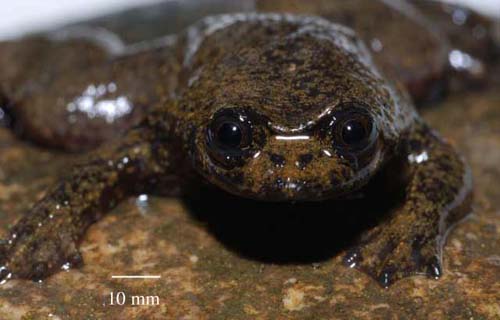Discovered strange frogs without lungs
The first frog without lung was discovered hiding in Borneo forest, Indonesia. This mysterious amphibian, called Barbourula kalimantanensis, often takes oxygen through its skin.

The first frog without lung was discovered hiding in Borneo forest, Indonesia.(Photo: David Bickford)
The researchers saw one of these frogs 30 years ago, but due to their small numbers, they only caught one and did not perform surgery.
"Nobody thinks about unlocking it - they don't imagine that it doesn't have lung," said researcher David Bickford of the National University of Singapore.
This amphibian species, no more than 5 cm long, often lives in cold rivers in remote areas of tropical forests Kalimantan, Borneo. They are very slippery and can jump very fast. "We have 11 people looking for this frog and it takes 2 weeks to find one , " Bockford said.
When the researchers began surgery on the captured organism, they were surprised to find that it had no lungs. Other internal organs are also very odd. All the rest of the abdomen is repositioned to fill the space left for the lungs. "So we see the stomach, spleen and liver above the lung cavity," Bockford said. "What's interesting is that we also found that some unusual cartilage is supposed to be lung."
According to the researchers, not having the lungs helps frogs to maximize the surface of the skin, helping them to absorb oxygen better. The group thought that lung loss could be a way to adapt to their cold habitat. Such waters have high oxygen content. In addition, frogs can swim underwater instead of floating in the flow, so having no lungs will help them dive better.
However, there are still many mysteries about this frog. "We don't even know what they eat? How do they live and attract their mates? How are their eggs? Do they lay eggs, have tadpoles? What are their living conditions? Bickford said.
The immediate goal of the researchers is to find more support to preserve this rare animal in Borneo.
- Strange frogs in the world
- Scientists discovered poisonous frogs with glowing bones through the skin
- Discovered frogs emit monstrous cries
- Scientists discovered frogs that eat all the same meat
- Interesting findings: Colorful colors help frogs
- Strange frogs
- Use algorithms to detect extinct frogs
- Found 14 new species of frogs
- When threatened, frogs can turn their toes into claws
- Frogs sing like birds in Vietnam
- The poisonous, strange creatures of the deep forest of South America
- Discovered frogs with feathers and sharpness
 Animal 'suffering' after hibernation
Animal 'suffering' after hibernation Why do goats climb well?
Why do goats climb well? Scientists were surprised to see chimpanzees eating turtles
Scientists were surprised to see chimpanzees eating turtles Giant catfish died deadly due to drought in Thailand
Giant catfish died deadly due to drought in Thailand